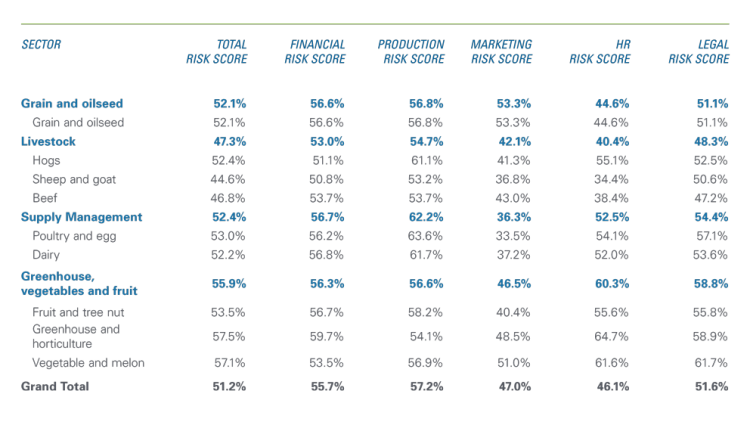How well are Canadian farms managing risk? FCC survey breaks it down

Risk in agriculture is always evolving - but are producers keeping up? An FCC Vision Survey, asked over 2,000 farm operations across the country about their risk attitude, concern levels and risk management strategies.
The survey found that 87% of Canadian farm operations have implemented strategies to mitigate the risks they reported regarding their operation. And while that statistic is impressive, it only reflects their strategies for areas they reported as “concerning.”
There are many reasons producers wouldn’t implement a risk management strategies:
Their risk preference or attitude
Failure to assess risk properly
Perceiving them as ineffective
To better understand farm operations’ areas of concerns, let’s dig into the survey results.
How the survey scored risk
Risk in the survey fell under five categories: financial, production, marketing, human resource and legal. We computed two risk management scores from the survey (Table 1):
Producer-identified risk score: Risks identified as of concern by operations who have implemented a risk mitigation strategy.
Total risk score: All risks listed in the survey where operations report using a risk mitigation strategy.
Canadian farm operators have implemented strategies to manage 51% of the risks listed in the survey. This score is 35 percentage points lower than the risk management score computed where risk is reported as a concern to the operation.
Table 1: Comparison of producer-identified and total risk management scores

Each risk category records at least a 30-percentage point difference in risk management between risks of concern for operations and all risks listed in the study.
Human resources and marketing are the two risk categories with the lowest total scores at 46% and 47%, respectively. These categories also represent the areas with the largest changes in risk scores, down 38 and 37 percentage points.
Leaders in managing HR risk – horticulture, supply management and hog operations
Greenhouse, vegetable and fruit operations have the highest total risk score of all sectors (Table 2). These farms are highly dependant on hired labour with strong incentives to implement mitigation strategies to manage HR risks.
Supply management and hog operations also report high scores. Family labour, employee mental health, transition plans, disruptions to operations due to accidents, and other contingency plans are all part of an effective HR risk management strategy. Employee wellbeing is the HR risk most often unaddressed by operations.
Table 2: Sector scores by risk categories

Grain and oilseed producers use the most marketing risk strategies
There’s a large discrepancy in marketing risk scores across agriculture sectors (Table 2). This can be explained by an industry’s structure (number of buyers/processors, marketing rules, etc.) and the overall volatility of commodity prices. Grain and oilseed operations scored the highest, relying on various tools ranging from fixed price and basis contracts to more sophisticated like futures and options. Many other sectors do not have the same access or need for these tools.
Having an effective marketing risk management strategy isn’t only about mitigating output price volatility. It must also consider the risks of selling farm product, feed and livestock input price volatility and the Canadian dollar.
Legal risk management lowest for beef producers
Evolving consumer food preferences, technological advancements, and sophisticated contracts have created emerging and expanded legal risks for producers. To protect against these, farm operators can rely on legal professionals to review contracts and ensure compliance with contract terms. Supply-managed and horticulture record the highest legal risk management scores. Conversely, the beef sector scores the lowest.
There’s no finish line when it comes to managing risk. Agriculture producers should always watch for new and evolving risk in their operations, understand their exposure and select the most effective management tools.
Craig Klemmer
Principal Economist
Craig joined FCC in 2009 as an Agricultural Economist, specializing in monitoring and analyzing the macroeconomic environment, modelling industry health, and providing industry risk analysis. Prior to FCC, he worked in the livestock branch of the Saskatchewan Ministry of Agriculture. Craig holds a Master of Agricultural Economics degree from the University of Saskatchewan.
